Best largemouth and smallmouth locales for 2008

In recent months, the editors of FLW Outdoors Magazine discovered bass anglers in Texas, Southern California and the Great Lakes region may be the luckiest folks in the fishing world. During that time, we assembled our list of the top bass-fishing destinations for 2008, and those regions of the country stole the show.
If you don’t live in Texas, California or Ohio, however, don’t fear. We don’t either. But we, along with a few FLW pros, took it upon ourselves to travel to the far stretches of the country to report back on the quality fishing on the lakes that follow – yeah, it was a tough assignment. Now we’ve turned it over to you to plan the trip of a lifetime to one of these fine fisheries.
Our picks all have one thing in common – the ability to produce rod-splintering bass by the boatload. They range from natural lakes to giant reservoirs to immense river deltas. There is a destination for anglers of all types. We even divided our picks between smallmouth and largemouth waters, so if you prefer bronze fish to green fish, we have it covered. And you will find Web addresses to local chambers of commerce for each location, so you have no excuse not to start planning.
While we hope you don’t grow tired of the scenery at your local bass pond, if you’re thinking about 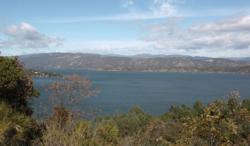 some time away, why not take a look at what America’s premier bass-fishing destinations have to offer?
some time away, why not take a look at what America’s premier bass-fishing destinations have to offer?
Top five largemouth fisheries
1. Clear Lake
If you don’t know about Clear Lake in Lake County, Calif., then you haven’t been keeping up with the times in bass fishing. The largest natural lake wholly in the state of California, Clear Lake is 43,000 acres of bass-fishing paradise.
The shores are lined with docks that offer gorilla-sized bucketmouths a place to ambush swimbaits, spinnerbaits and rip baits. Plenty of vegetation exists for pitching, flipping and deep jigging, and topwater lures are equally effective.
The four-day, professional-tournament weight record was set on this lake by pro Steve Kennedy in 2007. He threw a Huddleston Deluxe Trout swimbait to fool bruiser largemouths. His 20 bass weighed an amazing 122 pounds, 14 ounces, including one five-bass limit that weighed over 40 pounds. There aren’t many fisheries as special as this one, with opportunity to catch huge bass and an insane number of quality bass in the 4- to 6-pound range.
– Jason Sealock
Pertinent data: Clear Lake has a 12-inch minimum for largemouths; visit lakeportchamber.com or clearlakechamber.com for accommodations.
2. Falcon Reservoir
This month, Stren Series Texas Division anglers will have the opportunity to fish Falcon Reservoir during the lake’s peak season. Bass will be in their prespawn or spawn stage, and barring treacherous conditions that could prevail due to wind, FLW fans will find out what tremendous fishing the lake can produce. How tremendous? Tournaments held in recent summers brought limits in the mid- to upper 30-pound range. January limits should be heavier.
Falcon, which straddles the southern border of Texas, is at the mercy of drastically changing water levels due to irrigation needs. It has the potential to change by 60 feet over the course of a drought period, and when it’s low, the fishing slows – a little. FLW Outdoors Field Editor Matt Williams spent an outing testing deep-water spinnerbaits on Falcon in September in low-water conditions, and his “slow day” ended with a five-fish limit of 24 pounds.
Several factors make Falcon a tremendous fishery. Water temperature rarely dips below 55 degrees, giving the lake a nearly year-long growing season, and Falcon bass don’t know what diet means. They gorge on tilapia and crawfish, relying on 84,000 acres of submerged brush, farmsteads and pond dams to avoid predators, fill their bellies, and spin bass-fishing fanatics into a frantic frenzy. Come prepared to flip deep structure and brush at what may soon become the top destination for trophy largemouths.
– Curtis Niedermier
Pertinent data: Falcon has a 14-inch minimum for largemouths; it straddles the Mexican border; check regulations for fishing in Mexican water; visit zapatausa.com for accommodations.
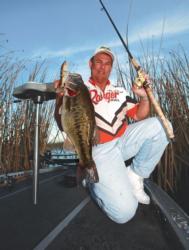 3. California Delta
3. California Delta
A sprawling, fertile tidal fishery, the California Delta winds through the lowlands of California between San Pablo Bay and the city of Stockton. The expansive estuary is formed near the confluence of the San Joaquin and Sacramento rivers. Ten-pound largemouths are common, as are five-fish, 30-pound limits. The stained water adds to the appeal of the fishery. It lets anglers get close and personal with gargantuan bass using braided line and a flipping stick through hundreds of miles of tules. Pitching Berkley PowerBait Sabertail Bugs in the tules or casting swimbaits, like the 3:16 Lure Co. Mission Fish; spinnerbaits; and lipless crankbaits across expansive grass flats and backwater ponds often leads to arm-breaking battles.
This isn’t the fishery for the faint of heart. Tides change constantly, and playing the tide is the name of the game if you want to catch trophies. While it is not as well-known for trophies as some smaller California fisheries, the enormous population of 4- to 6-pounders and the frequency in which double-digit bass are caught make this a destination every serious bass angler needs to visit at least once in their lifetime. A good place to start when attacking the Delta is Franks Tract, one of the most popular fishing areas, just outside Bethel Island near Oakley, Calif.
– Jason Sealock
Pertinent data: The California Delta has a 12-inch length limit; visit oakleychamber.com for accommodations.
4. Lake Amistad
Though word is out about this giant South Texas and Mexico border impoundment, Lake Amistad continues to amaze anglers and tournament fans alike. It seems 4- to 6-pound fish are everywhere in the lake, and 8-pounders are common. Typically, it’s going to take a double-digit bass to win a big-fish award during a springtime event. Last spring, during the March 2007 Stren Series Texas Division event at Amistad, pro Rick Turner of Tyler, Texas, caught the heaviest bass in FLW Outdoors tournament 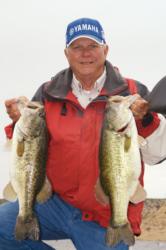 history – a 14-pound, 8-ounce toad.
history – a 14-pound, 8-ounce toad.
Amistad is an offshore-structure fisherman’s dream lake. It’s very deep and crystal-clear, inundated with ledges and ridges, many of which are lined with submerged trees and lush grass beds. During the early season (January and February), slow-rolling a big spinnerbait along those ledges can cause good things to happen.
A little later in the season, as the grass begins to thicken, expect a decent crankbait bite before bass begin taking a preference for slower-moving bottom baits, such as football-head jigs and big Texas-rigged Senkos.
Spring sight-fishing, provided the wind isn’t blowing, can be phenomenal on Amistad, and warm summertime weather makes offshore patterns productive.
– Will Brantley
Pertinent data: Amistad has a 14-inch minimum on largemouths; the lake straddles the Mexican border; check regulations for fishing in Mexican water; visit drchamber.com for accommodations.
5. Lake Fork
Lake Fork has been a big-bass factory since the day it opened. When the Texas Parks and Wildlife Department built Fork, they filled several soon-to-be-flooded ponds with Florida-strain brood fish – the fish formerly populating fisheries throughout the state. Having those hefty sows in the lake meant Fork offered 7- and 8-pounders when the first lure hit the water.
Since then, Fork has been managed to protect the fishery as a trophy-bass destination. A slot limit protects fish from 16 to 24 inches, and a recent big-bass competition saw more than 30 bass weighed in more than 24 inches long.
Lake Fork monsters don’t just fall to big-bass tournament anglers. Since 1986, nearly half of the more than 400 ShareLunkers caught in Texas came from Lake Fork. What’s a ShareLunker? Well, it’s a bucket-mouthed bass weighing at least 13 pounds taken from Texas waters and donated back to the state to be bred for stocking other trophy fisheries.
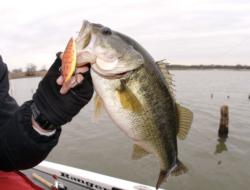 Catching ShareLunkers can be done with a variety of tactics because Fork offers something for every bass angler. Lily pads provide a seasonal frog bite; vertical jiggers can dangle jigging spoons on deep-water ledges; grass returning to the lake has produced a strong bite on soft jerkbaits and soft stick baits; and ever-present timber holds big bass for a variety of patterns. Put some thick line on a big rod and head to Lake Fork. And don’t forget the camera.
Catching ShareLunkers can be done with a variety of tactics because Fork offers something for every bass angler. Lily pads provide a seasonal frog bite; vertical jiggers can dangle jigging spoons on deep-water ledges; grass returning to the lake has produced a strong bite on soft jerkbaits and soft stick baits; and ever-present timber holds big bass for a variety of patterns. Put some thick line on a big rod and head to Lake Fork. And don’t forget the camera.
– Curtis Niedermier
Pertinent data: Largemouths under 16 inches and one over 24 inches may be kept; visit rainschamber.com for accommodations.
Top five smallmouth fisheries
1. Lake Erie
It’s huge, dangerous and intimidating for the novice Great Lakes angler, but if you know what you’re doing, catching 5-pound smallmouths by the boatload is more predictable in the fertile waters of Lake Erie than anywhere else in the country.
While big smallmouths can be found throughout Lake Erie, it’s the Western Basin that has the most famed reputation. Each spring, shortly after ice-out, smallies can be caught in numbers on offshore rock piles and humps while the water is still unbelievably cold. Drop-shot-rigged soft-plastic gobies, hair jigs and blade baits are the three primary lures. The weather can be brutal, and the fish can be tough to locate, but catching them can be easy once they’re located.
Although fish won’t typically stack up in numbers during summer like they do in the early spring, most bass tournaments on the big lake are held in the summertime, and it usually takes limits breaking the 20-pound mark to make it into the top five.
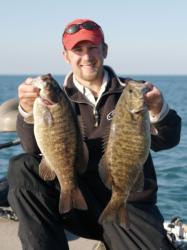 As summer progresses to fall, some of the best action of the year takes place. Many bass will be moving into river systems, such as the Detroit, to chase shad. Fishing lipless crankbaits and spinnerbaits is extremely productive and a lot of fun.
As summer progresses to fall, some of the best action of the year takes place. Many bass will be moving into river systems, such as the Detroit, to chase shad. Fishing lipless crankbaits and spinnerbaits is extremely productive and a lot of fun.
– Will Brantley
Pertinent data: a 14-inch length limit is in place during open seasons only; multiple state and country regulations apply; check with local wildlife agencies for season dates; visit portclintonchamber.com for accommodations.
2. Burt and Mullet lakes
Michigan natives often use their hand as a map when showing new friends where their hometown is located. Somewhere near the tips of the index and middle fingers is a smallmouth fishery, which Northern anglers have apparently been keeping secret. Burt and Mullet lakes are twin fisheries, connected by the Indian River, and part of the 40-mile Inland Waterway, which eventually dead-ends into Lake Huron.
Perhaps such close proximity to the Great Lakes has kept the lakes under the radar, but for Wal-Mart Bass Fishing League anglers, the secret was out in June. Nine of the top ten finishers at the Wal-Mart BFL Michigan Division event on Burt Mullet sacked at least 20 pounds. The 10th-place finisher came up 1 ounce shy.
Dave Schneider, of Alpena, Mich., finished second in the event, and he considers the system his home water. A recent summer drop-shot outing for Schneider produced eight fish over 5 1/2 pounds, including one over six, and bigger fish are still lurking.
Burt Lake is collectively recognized as the place to hang a monster smallie, but Mullet is more reliable for numbers. Both lakes fish much like the Great Lakes, with tubes being the go-to baits. Spinnerbaits are deadly around sunken timber remains from the old logging industry, and fall weather lights up the crankbait bite. Don’t expect much competition on the lake though; it’s not uncommon to spend five days alone on the water. Tell your friends, or maybe make it your secret hot spot.
– Curtis Niedermier
Pertinent data: Both lakes have a 14-inch minimum for bass; check with local wildlife agencies for season dates; visit irchamber.com for accommodations.
3. Lake St. Clair
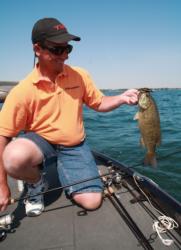 With 275,000 surface acres of fishable water, Lake St. Clair offers smallmouth bass plenty of area to gang up and feed. For the most part, it’s a shallow-water smallmouth paradise. The lake only averages 10 feet deep, although there are spots that are deeper than 30 feet.
With 275,000 surface acres of fishable water, Lake St. Clair offers smallmouth bass plenty of area to gang up and feed. For the most part, it’s a shallow-water smallmouth paradise. The lake only averages 10 feet deep, although there are spots that are deeper than 30 feet.
The blue waters are not only easy to pattern, but massive schools can be found when anglers do their homework. The only thing that alters the fishing on this waterway is closed seasons both in the United States and Canada.
If you like to burn a spinnerbait or snap a jerkbait for smallies over spacious flats, then St. Clair is your destination. Of course, dragging a tube will catch numbers of fish, but we can tell you firsthand, the new YUM Doozee, YUM Wooly Bug, and a Berkley Gulp! Minnow or Leech will slay the smallmouths on this blue-water fishery. It usually takes 20- to 25-pound limits to win tournaments on the lake, and anglers can expect more 3- to 5-pound bass than they care to count, with 6-pounders becoming more common than in years past.
– Jason Sealock
Pertinent data: St. Clair has a 14-inch minimum-length limit; visit metroeastchamber.org for accommodations.
4. Lake Champlain
Champlain sprawls across the New York and Vermont border, near the towns of Plattsburgh, N.Y., and Burlington, Vt. While it is a tremendous largemouth fishery, as evidenced by many professional tournaments in recent years, the smallmouth fishing is still one-of-a-kind. Champlain is deep and clear and features both jagged offshore rock piles and shallow, jungle-like grass flats.
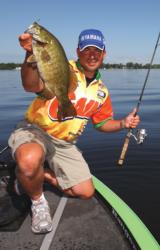 If sight-fishing for smallmouths is your game, few lakes offer better opportunities than Champlain in May and June. Smallmouths litter flats with beds, and the better-quality bass often make beds deeper than 10 feet.
If sight-fishing for smallmouths is your game, few lakes offer better opportunities than Champlain in May and June. Smallmouths litter flats with beds, and the better-quality bass often make beds deeper than 10 feet.
Equally effective in the spring are crankbaits and jerkbaits. Spinnerbaits have their place too, but day in and day out, a tube, a Senko or another soft-plastic imitator on a drop-shot will tempt bronzebacks on this waterway. Anglers should expect many 2- to 4-pound smallmouths, with an occasional 5-pounder mixed into their catch.
– Jason Sealock
Pertinent data: Champlain has a 10-inch minimum on bass; visit northcountrychamber.com for accommodations.
5. Dale Hollow Lake
If you’ve never been to Dale Hollow Lake, you aren’t the only one. The lake, which stretches across the Kentucky and Tennessee border, is off the beaten path and a good distance from any highway, but it offers the best smallmouth fishing in the South.
The world-record smallmouth, an 11-pound, 15-ounce beast, was pulled from Dale Hollow in 1955. Today, a slot limit allowing anglers to keep one smallmouth under 16 inches and one over 21 inches 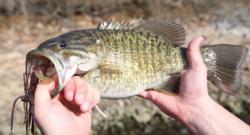 protects the descendants of that fish, ensuring the lake’s place as a trophy-smallmouth haven for years to come.
protects the descendants of that fish, ensuring the lake’s place as a trophy-smallmouth haven for years to come.
Dale Hollow is a winding, gin-clear impoundment built on boulders and rocks. Sight-fishing is hard to beat in the spring. Summer fishing is best at night, and guides in the area offer evening trips. As cool temperatures arrive in November and December, a phenomenal crankbait bite makes catching fish easy on windy points.
A 3-pound average is more than common on the lake, while 6-pounders emerge during all seasons. That may not entice Great Lakes anglers, but winter doesn’t bring ice shanties and short poles to Dale Hollow. In fact, cold weather brings the hottest fishing, making Dale Hollow a year-round must-visit for smallmouth enthusiasts.
– Curtis Niedermier
Pertinent data: Anglers may keep one smallmouth under 16 inches and one fish over 21 inches; a 15-inch minimum exists for largemouth bass; certain portions of the lake require Tennessee or Kentucky license; check with local wildlife agencies for details; visit dalehollowlake.org for accommodations.